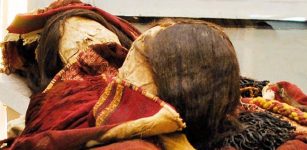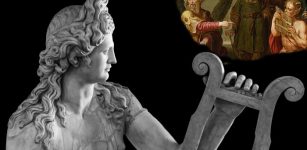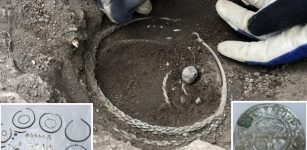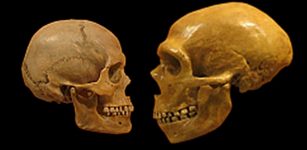Prince John’s Plot Against King Richard The Lionheart
David Tee - AncientPages.com - Prince John did not have a good reputation.
Historian W. L. Warren probably described Prince John the best when he wrote, “By comparison with Richard, John has been seen as a weedy little tick.” The reason for this disturbing personality in John could have been jealousy. Richard was beloved, a good king, older and taller than John.
Left: Prince John. British School – School Details of artist on Google Art Project. Credit: Public Domain - Right: 19th-century portrait of Richard the Lionheart by Merry-Joseph Blondel. Credit: Public Domain
Prince John (1166 - 1216), also known as John Lackland, was the last child of Henry II and Eleanor of Aquitaine and was born on Christmas Eve in 1137 AD. Even being born in a festive spirit had no influence on John’s character. Richard had everything John did not
Another factor that could have given rise to Prince John’s attitude was that King Henry II had no more land to give him when he was born. John was a prince without a kingdom.
Prince John Was A Failure
There is no polite way to describe the life and person of Prince John. Once his father tried to make him king of Ireland, but his behavior toward the Irish leaders caused a rebellion and forced his departure from that country.
Even his attempt to dethrone his brother failed miserably. The conflict between John and Richard may have started when their father ordered Richard to give John Aquitaine. The former refused, and Henry II told John jokingly to invade Richard, which John proceeded to do.
This invasion failed as well. John also lost most of his father’s empire in France.
Prince John’s Plot Against His Brother, Richard The Lionheart
One good thing that can be said about Richard the Lionheart was that he was a warrior. When the time came for another Crusade against the Arabs controlling the Holy Land, Richard responded with men, leadership, and other contributions.
Richard I pardons his brother Prince John at the behest of their mother, Eleanor of Aquitaine. Credit: Public Domain
It was the change that John could have been waiting for. With Richard gone, he could rule in his stead and do as he pleased. But when Richard did not die in the Crusade, John conspired with Duke Leopold of Austria and Philip Augustus of France to keep Richard in prison and away from England.
Unfortunately for John, this plot failed as well. He and Philip tried to bribe Henry VI to hand Richard over to them, but Henry VI’s nobles did not like the change of heart and compelled Henry to keep his original promise.
Richard was eventually released from his captivity, and John fled England and went to France. Of course, during this time, John’s mother organized a rebellion against John and helped Richard return to the throne.
John Was Not A Good King
Historians have compared John to the Roman Emperor Caligula. They both murdered to get to the top, stole from nobles, abused the courts, and even lost their French empire due to cowardice.
The acts of John were outrageous in their own right, as he had a friend’s wife and child starved to death. He also used devious means to revoke the power of his brother Richard’s allies. Most of this was done apparently before John reached the throne legitimately.
Prince John did eventually become King John. On his deathbed, the story goes that Richard made John his heir despite his older brother’s son’s better claim to the throne. This act did not sit well with Arthur, the son, and John had more problems on his hands.
A romanticised 19th-century recreation of King John signing Magna Carta. Rather than signing in writing, the document would have been authenticated with the Great Seal and applied by officials rather than John himself. Image credit: James William Edmund Doyle - (1864) "John" in A Chronicle of England: B.C. 55 – A.D. 1485, - Public Domain
The Magna Carta Comes Into Existence
It is said that King John may not have been a very good person or king, but he left a very good piece of legislation to govern England and other countries. We can only disagree with that thought because it was probably John’s subjects that should get the credit for constructing the Magna Carta and forcing King John to sign and agree to it.
The Magna Carta was sealed on June 15, 1215.
The Magna Carta was not a product of a lousy king but a result of good people coming together to stop the evil John was doing. It is doubtful that a man known for killing his enemies, like starving the knights at Corfe Castle, would devise a plan restricting his power.
John eventually contracted dysentery and died.
His son, Henry III, ascended the throne. King John is buried at Worcester Cathedral.
Written by – David Tee AncientPages.com
Updated on December 11, 2022
Copyright © AncientPages.com All rights reserved. This material may not be published, broadcast, rewritten or redistributed in whole or part without the express written permission of AncientPages.com
Expand for referencesMore From Ancient Pages
-
 DNA Reveals Early Maya Trace Their Roots To Unknown Ancient Immigrants Carrying Maize From The South
Archaeology | Mar 22, 2022
DNA Reveals Early Maya Trace Their Roots To Unknown Ancient Immigrants Carrying Maize From The South
Archaeology | Mar 22, 2022 -
 What The Egg Crisis Reveals About Our Food System
Archaeology | Apr 24, 2023
What The Egg Crisis Reveals About Our Food System
Archaeology | Apr 24, 2023 -
 Evidence Of Rare Roman-Celtic Temple Near Lancaster Castle
Archaeology | Mar 9, 2023
Evidence Of Rare Roman-Celtic Temple Near Lancaster Castle
Archaeology | Mar 9, 2023 -
 Unique Over 1,000-Year-Old ‘Telephone’ Invented By A Lost Forgotten Civilization With No Written Language
Civilizations | Aug 24, 2018
Unique Over 1,000-Year-Old ‘Telephone’ Invented By A Lost Forgotten Civilization With No Written Language
Civilizations | Aug 24, 2018 -
 Chilean Mummies Clad In Red Poison Dresses – Evidence Of A Unique Inca Ritual
Archaeology | Jul 28, 2018
Chilean Mummies Clad In Red Poison Dresses – Evidence Of A Unique Inca Ritual
Archaeology | Jul 28, 2018 -
 Giant Ancient Roman Underground Structure Discovered Near Naples, Italy – Aqua Augusta Investigated
Archaeology | Feb 6, 2023
Giant Ancient Roman Underground Structure Discovered Near Naples, Italy – Aqua Augusta Investigated
Archaeology | Feb 6, 2023 -
 Did An Extraterrestrial Spacecraft Land In Ancient China? Remarkable UFO Accounts From The Past
Featured Stories | Nov 17, 2014
Did An Extraterrestrial Spacecraft Land In Ancient China? Remarkable UFO Accounts From The Past
Featured Stories | Nov 17, 2014 -
 Cheomseongdae “Star-Gazing Tower” Is The Oldest Observatory In East Asia
Featured Stories | Mar 31, 2021
Cheomseongdae “Star-Gazing Tower” Is The Oldest Observatory In East Asia
Featured Stories | Mar 31, 2021 -
 Pottery Found On Jiigurru/Lizard Island Rewrites Aboriginal History
Archaeology | Apr 12, 2024
Pottery Found On Jiigurru/Lizard Island Rewrites Aboriginal History
Archaeology | Apr 12, 2024 -
 Apollo Punished Rivals For Their Extraordinary Musical Skills
Featured Stories | Apr 19, 2022
Apollo Punished Rivals For Their Extraordinary Musical Skills
Featured Stories | Apr 19, 2022 -
 Lemminkainen: Mythical War-Hero Of Finnish Great Epic ‘Kalevala’
Featured Stories | Oct 14, 2016
Lemminkainen: Mythical War-Hero Of Finnish Great Epic ‘Kalevala’
Featured Stories | Oct 14, 2016 -
 Enigmatic Denisovans Interbred With Modern Humans More Than Once
Archaeology | Mar 22, 2018
Enigmatic Denisovans Interbred With Modern Humans More Than Once
Archaeology | Mar 22, 2018 -
 Unique Viking Age Silver Treasure Found On Farm Near Stockholm In Sweden
Archaeology | Nov 12, 2020
Unique Viking Age Silver Treasure Found On Farm Near Stockholm In Sweden
Archaeology | Nov 12, 2020 -
 Neanderthals Had Capacity To Speak And Understand Language Like Humans
Archaeology | Mar 2, 2021
Neanderthals Had Capacity To Speak And Understand Language Like Humans
Archaeology | Mar 2, 2021 -
 Are The Strange Lawrence Brook Carvings In New Jersey A Cryptic Message?
Featured Stories | Feb 10, 2023
Are The Strange Lawrence Brook Carvings In New Jersey A Cryptic Message?
Featured Stories | Feb 10, 2023 -
 Underground Hellenistic Necropolis With Tombs With Frescoes, Reliefs Unearthed In Naples, Italy
Archaeology | May 13, 2023
Underground Hellenistic Necropolis With Tombs With Frescoes, Reliefs Unearthed In Naples, Italy
Archaeology | May 13, 2023 -
 Unknown Purpose Of The Mysterious Huge Iron Age Ceramic Sharjah Jar Puzzles Scientists
Archaeology | Oct 7, 2022
Unknown Purpose Of The Mysterious Huge Iron Age Ceramic Sharjah Jar Puzzles Scientists
Archaeology | Oct 7, 2022 -
 Secret Group Searching For Ancient Giants’ Skeletons In NZ Worries Archaeologists
Archaeology | Mar 19, 2020
Secret Group Searching For Ancient Giants’ Skeletons In NZ Worries Archaeologists
Archaeology | Mar 19, 2020 -
 Central Asia Identified As A Key Region For Human Ancestors
Archaeology | Oct 22, 2022
Central Asia Identified As A Key Region For Human Ancestors
Archaeology | Oct 22, 2022 -
 Tír na nÓg – Mythical Land Where Time Floats Slower Than In Mortal Lands
Celtic Mythology | Mar 2, 2020
Tír na nÓg – Mythical Land Where Time Floats Slower Than In Mortal Lands
Celtic Mythology | Mar 2, 2020



